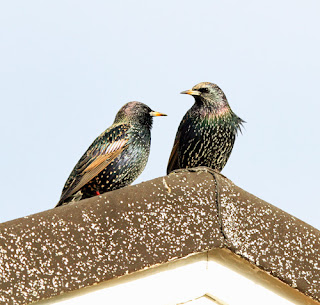It's been a while since I've posted any of my night time sounds which I've recorded moving over the Lytchett Bay's listening station. One of the biggest problems is that the parabola is fixed facing the sky so to get a good recording the birds have to fly directly over it calling, unfortunately the birds do not know how to cooperate in this matter. Though I can identify many of the birds sound I hear with a headset on if I increase the volume of the calls it also increases the background noise as well. This is one of the problems with doing this kind of science at the edge of an urban area. Which means many of the calls cannot be used to publish and I have to wait for a cooperative bird to fly close enough to give a good recording. If you cannot hear the sounds below listening with a headset should improve your listening experience if I can call it that.
1. This is a typical flight call from a Moorhen I presume it was a migrant though it could easily be a local bird transient between feeding areas in the bay.
 |
| Moorhen - Spectrogram |
2. Green Sandpipers are a regular visitor to the Lytchett Bay/Fields and at times in the autumn we can get well into double figures on the Sherford pools. So it wasn't a total surprise that at sometime I would eventually record one flying past.
 |
| Green Sandpiper - Spectrogram |
3. In the last twenty years of recording the birds in the Lytchett Bay recording area Ring Ouzel has been a pretty scarce visitor so to record six individual over a couple of weeks flying over or past the listening station ask the question is this a regular autumn occurrence which it could well be. It just that they do not land but are pushing on to the Purbeck coast and Portland to rest and have a feed before jumping off across the channel. Only time will tell.
4. This last one was a bit of a surprise in that we have had a few recent records of a single Barn Owl over the fields west of the bay and near to the Bakers Arms roundabout, but to record a night-time call from the garden listening station was really excellent which makes it 'three owls' on the garden list. I'm not sure if this bird was perched in the wood or called as it flew past either way it was a good record and it's surprises like this that makes the time and effort worth while. We just do not know what is travelling around overhead during the night whilst we are all tucked up warm in bed.
 |
| Barn Owl - Spectrogram |
Over the last year I have put more time into the night time recording and I have managed to record sixty four different species of bird plus a few mammals, you just don't know what is going to turn up next.
I hope you have found these sounds of interest and I'll sort a few more out soon for another blog.










